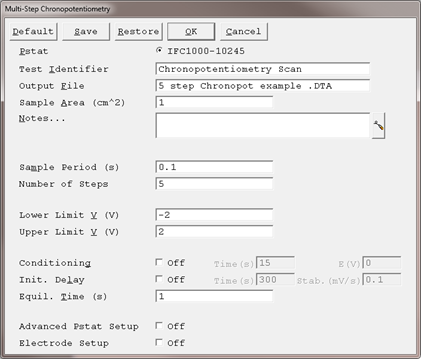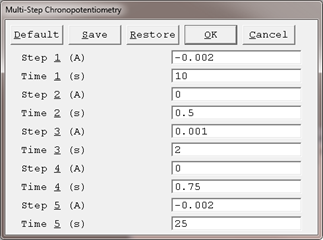
This is an extension of Gamry Instruments’ Chronopotentiometry script. Chronopotentiometry is restricted to two potential steps. This script allows tests with more complex waveforms containing up to 48 steps.
This is a multipurpose test. It is often used to apply unusual waveforms for specialized experiments. One example is a form of pulse plating where the primary plating step is followed by relaxation, a stripping step, relaxation, and then additional plating.
This script is particularly useful when the step times are short (< 5 s) and the time between steps must be short and reproducible.
NOTE: When the step times last 5 s or more, Gamry’s Sequence Wizard offers even more flexibility. Unfortunately, the Sequence Wizard has 10 s of milliseconds time delay between the steps. Consequentially, Fast tests in the Sequence Wizard can suffer from timing problems.
The Setup for a Multiple-Step Chronoamperometry test involves a number of Setup dialog boxes.
The first window contains general Setup items. Most of these items apply to all the steps in the test. The picture below shows a typical first Setup window. This window and those that follow assume we are setting up a five-step plating example.

Many of the Setup parameters in this window are similar or identical to Setup parameters in the Chronopotentiometry Setup window. These will not be discussed here.
The Number of Steps parameter is new in this Setup. In this test, you can have up to 48 steps. If you enter a larger value, the script reports an error message.
NOTE: The data entry for a 30- or 40-step test takes a long time and is susceptible to error. If you need to set up a complex multi-step test, we strongly recommend you save your Setup using the Save Restore mechanism in Gamry’s Setup screens. All the Setup window needed in a multistep test can be saved in one Set file/Set name combination. We also recommend you try the test on a resistive cell before running it on a real cell.
The Sample Period parameter is applied to all the steps in the test.
In practice, this can disallow wide time disparity between steps. A 20 µs step followed by a 1 s test must have 10 µs per point sampling (or faster). At 10 µs per point, the slower step measures 100 000 data points, which exceeds the maximum number of data points allowed in a data curve.
If you click the OK button in the window described above, a second window appears (assuming you did not select the Advanced Pstat Setup or the Electrode setup). The next screenshot shows an example of the second Setup window for our five-step plating example. This dialog box only sets up the five steps we requested. These Setup windows can set up a maximum of eight steps. You need three Setup dialog boxes for a 20-step test.

When you click the OK button on the last Setup window, the test runs.
The real-time display shows a graph of current and voltage versus time. All steps are shown on one plot.
You can graph and analyze the data file for this test with our Echem Analyst™.